Design Visualization and the Desktop Engineer
No longer simply used for presentation, visualization techniques have moved to the front of the product-development process.
Latest News
January 1, 2009
By Mark Clarkson
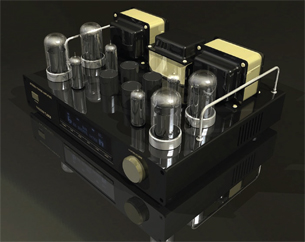 This stunning image was created using LightWorks within TrueSpace by Flavio Adriani. |
“Visualization is critical to the design process.” That’s the appraisal of Chris Ruffo, design visualization industry manager at Autodesk. “As one of our customers said, ‘Visualization is no longer a presentation tool; it’s a design tool as well.’ ”
Consider headlights. Automotive designers spend an astonishing amount of time and energy in getting all the curves, corners, and reflections just right. “A headlight prototype costs $90,000 to build,” says Ruffo. “You can imagine that manufacturers are interested in streamlining that design process. Accurate visualization, with ray-tracing, reflections, and caustics, allows them to make decisions in virtual space, using digital prototypes.”
Modern renderers do produce very accurate results. “We can take digital descriptions of real-world lenses,” says Jay Roth, president of Newtek’s 3D division, “and reproduce that lens perfectly ]in LightWave 3D], including accurate depth of field and motion blur. We have physically accurate materials. We have IES-spec lights. We can take EXIF data from digital cameras, and read all the characteristics of the camera. You can really match real-world environments with frightening detail with very little work.”
So, What’s Next? More Speed.
“The major improvement that people are always asking for is speed,” says Randy Ochs, VP of North American business development and sales at mental images. Instead of waiting minutes or hours, users want rendering to be interactive and instantaneous.
“We will have updates to our mental ray renderer next year that will provide interactive ray tracing at something like 30 frames per second.”
Where will this horsepower, expected to drive this increase in speed, come from? Your graphics card.
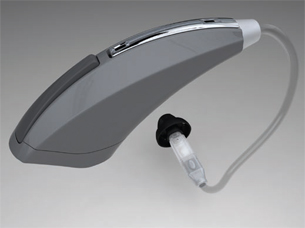 This is a HyperShot rendering of the Zon hearing aid by Stuart Karten. |
Largely unnoticed by many, graphics cards have evolved into potent computers in their own right. The GPU (graphics processing unit) on ATI’s RadeonHD 4870 X2 graphics card boasts a massively parallel architecture capable of a stunning 2.4 teraFLOPS.
Consider also NVIDIA’s Tesla. While it churns out images and video, it does not have any direct way of displaying them; there’s no video output; you can’t plug it into a monitor. It’s a number-crunching graphics computer on a card. NVIDIA builds a series of servers around the Tesla, and has developed a whole environment — CUDA — for programming them.
A small but growing community is exploring general-purpose computation using graphics hardware. (Learn more at gpgpu.org.) And commercial application developers are very interested too, of course.
“When we ported AliasStudio to Windows,” says Colin Smith, Autodesk AliasStudio product manager, “we saw the opportunity to take advantage of the power on these graphics cards. It made sense for us to give designers the power to see their models in a real-time environment rather than waiting for a software render.”
AliasStudio uses the GPU in combination with the OpenGL shading language to achieve its real-time renders.
Easy, Peasy, Lemon-Squeezy
Photo-realistic rendering has a well-earned reputation for being slow and difficult to achieve. Many don’t even want to consider adding it to their workflow. “My biggest competitor is inertia,” says Thomas Teger, Bunkspeed’s director of marketing and strategic planning. “That’s why we talk about Hypershot, not as a renderer, but as a digital camera for your digital data. You’re using a camera, and it’s all about creativity again. There is no learning curve.”
Hypershot is a stand-alone renderer focusing on ease of use and speed. Targeted at non-experts, it produces accurate shadows, reflections and, refractions in near real-time. Autodesk is pursuing a similar course with its Showcase application.
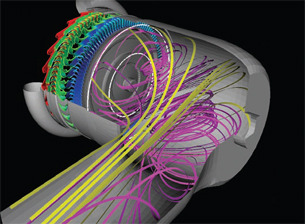 Turbine flow analysis visualized courtesy of EnSight. |
Showcase and Hypershot both use high dynamic range images (HDRI) as their basic lighting model. HDRI photos ‘become’ the light, accurately recreating the lighting and reflections of the photographed environment. HDRI lighting is probably the easiest way to create realistic lighting in a scene, much easier than futzing about with multiple lights.
While Showcase leverages the power of the GPU to achieve real-time results, Hypershot makes clever use of the CPU.
FEA Made Fast and Easy
This trend toward application simplicity appears in other areas of visualization as well. “The near-term market for us,” says Kevin Colburn of Computational Engineering International (CEI), “is ‘non-expert’ users.” CEI makes EnSight, a postprocessing package using FEA, CFD, and CAD data to produce interactive, real-time visualizations.
“Typically,” says Colburn, “you’ve had to be a Jedi Knight to use engineering simulation software. But as CFD and FEA programs are being used by more and more small companies, we’re catering to a less sophisticated crowd. We focus on interactivity, on making visualizations that are as dynamic and engaging as possible, so non-engineer types can still understand the flow field, the stresses…all the implications of their design.
“The benefit of doing simulation is being able to affect a change in your design. To do that, you need to be able to communicate those results to people in a way they can understand. If you’re not able to do that, then CFD or FEA is completely useless.”
3D on The Web
If you’re communicating engineering results, especially across companies and continents, there’s no better vehicle than the web. “The current approach to 3D on the web is client-based,” says mental images’ Ochs. “It requires plugs-ins, and the viewing is dependent on client hardware and software capabilities.”
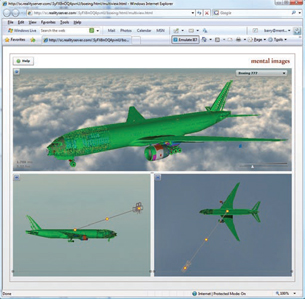 A complete CAD model of the Boeing 777, complete with every bolt and wire, presented in real time with mental image’s Reality Server. |
mental images’ Reality Server, in contrast, renders on a server, or server cluster, then streams the results over the Internet to a client as a series of simple JPGs or PNGs at a rate of 10 to 30 frames per second. You can view, say, a 25GB model of a Boeing 777, with every duct, bolt, and wire. You can rotate, pan, and zoom it in real time, on your desktop PC, or your laptop, or even on your iPhone. Customers can try out different paint jobs and interior schemes; mechanics can access CAD data for the nacelles. Widely dispersed groups can work on the same model, at the same time.
“You need a broadband Internet connection,” says Ochs, “but I don’t know what hardware and software you have, nor do I care.”
Rendering on a Cloud
The engineering data remains secure on a server that the manufacturer controls. In the case of the Boeing 777 demo I saw, that server was a dual quad-core Intel server with 32GB of RAM and an NVIDIA Quadro 5600. Meaty by desktop standards, but I was still surprised to see it rendering an 800 million polygon model in real time.
With Reality Server, mental images is staking a claim in a new area of technology space. “We think that’s going to be the next major paradigm shift in the rendering industry,” says Ochs. “You’ll be able to choose between interactive ray tracing on your desktop computer and leveraging large computing servers on the cloud.
“A certain subset of the market will say, ‘I don’t want to wait two hours for this file to render on my desktop computer. I’m going to send this to a cloud computer server where they can throw thousands of CPUs and CPUs at it and send me the result back immediately.”
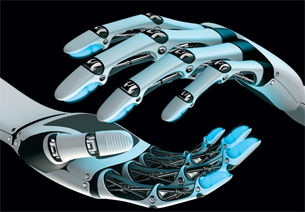 Showcase from Autodesk uses high dynamic range images (HDRI) as its basic lighting model. HRDI photos “become” the light, accurately recreating the lighting and reflections of the photographed environment. |
Scalability is an issue on the desktop, too. Hardware vendors are in a race to put more and more cores into our machines, and application vendors are wrestling to squeeze every drop of speed out of them all.
Visualization’s Everywhere — What Will You Do With It?
The faster and easier it is to produce realistic images, the further rendering penetrates into every aspect of the design process. “Rendering in ‘traditional’ CAD applications,” says Rona Treeby, marketing manager of LightWork Design, “typically used to happen at the end of the design process. ]It required] a high degree of user skill. Today, rendering has a much broader appeal in a variety of markets, and can be found in a wide and varied range of applications, from traditional CAD tools right through to ‘point of sale’ tools in the local DiY store.”
“An exciting aspect of this,” says Autodesk’s Ruffo, “is where our customers can take things once they have this technology in their hands, to validate, prototype, simulate, and analyze their designs. And, as they move through into sales and marketing, the kind of experiences they can create by leveraging their existing design data and creating experiences that can be played back on this new hardware technology.
“And it’s brought to you by gaming technology, which is kind of neat too.”
Visualization Resources
Actify Inc.
San Francisco,CA
AccuRender
Seattle,WA
Adobe
San Jose,CA
Advanced Visual Systems Inc.
Waltham,MA
Advizor Solutions
Downers Grove,IL
ALGOR, Inc.
Pittsburgh, PA
AMD
Sunnyvale,CA
ARTVPS
Cambridge,UK
Autodesk, Inc.
San Rafael,CA
AutoDesSys
Columbus,OH
Blue Ridge Numerics
Charlottesville, VA
Bunkspeed
Carlsbad,CA
CA, Inc. (formerly NetViz)
Islandia,NY
Caligari Corporation
Redmond,WA
ClockWise Technologies Ltd.
Tel-Aviv,Israel
Computational Engineering Intl.
Apex, NC
COMSOL, Inc.
Burlington, MA
Dassault Systemes
Paris, France
Data Desk
Ithaca, NY
DeskArtes
Helsinki,Finland
Enggsoft
Singapore
Eos Systems
Vancouver,BC
Eovia
Merignac,France
Exa Corp.
Burlington, MA
HiveGroup
Richardson,TX
Hyperion Solutions
Redwood Shores,CA
ILOG
Sunnyvale,CA
Immersive Design
Acton, MA
Informatica
Redwood City,CA
Information Builders
New York,NY
Insightful
Somerville,MA
Integrated Engineering Software
Winnipeg, MAN
Intelligent Light
Rutherford,NJ
Inxight
NewtownSquare, PA
LightWork Design
Sheffield,UK
MacroFocus
Zurich, Switzerland
McNeel North America
Seattle,WA
mental images GmbH
Berlin, Germany
NAG, The Numerical Algorithms Group
Oxford, UK
NewTek, Inc.
San Antonio,TX
NVIDIA
Santa Clara,CA
Oculus Info
Toronto,Ontario, Canada
Okino Computer Graphics
Toronto, ONT
PanOpticon
New York,NY
Piranesi
Cambridge,UK
PolyVista
Houston,TX
ProClarity
Redmond,WA
Siebel Systems
Oracle’s Siebel CRM
Redwood Shores,CA
SiTex Graphics
Denton, TX
Tableau Software
Seattle,WA
Tecplot, Inc.
Bellevue,WA
T-Splines, Inc.
Provo, UT
TechViz
Paris, France
Visual Components
Helsinki,Finland
Visual Numerics
Houston,TX
Viz
Pittsburgh,PA
VizUp
Vancouver,BC
Contributing Editor Mark Clarkson, a.k.a. “the Wichita By-Lineman,” has been writing about all manner of computer stuff for years. An expert in computer animation and graphics, his newest book is “Photoshop Elements by Example.” Visit him on the web at markclarkson.com or send e-mail about this article c/o [email protected].
Subscribe to our FREE magazine, FREE email newsletters or both!
Latest News
About the Author
Mark ClarksonContributing Editor Mark Clarkson is Digital Engineering’s expert in visualization, computer animation, and graphics. His newest book is Photoshop Elements by Example. Visit him on the web at MarkClarkson.com or send e-mail about this article to [email protected].
Follow DE





